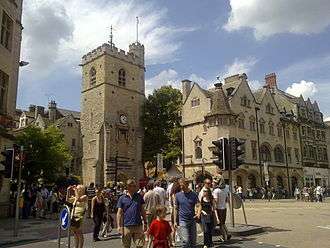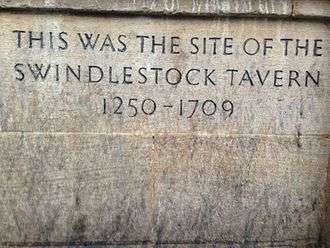St Scholastica Day riot

The St Scholastica Day riot of 10 February 1355 is one of the more notorious events in the history of Oxford, England.[1] Sparked off by a tavern dispute between two students and a taverner, the riot lasted two days and resulted in a large number of deaths among local citizens and students. The ensuing pacification led to a reinforcement and enlargement of the privileges and liberties of the academic institutions over the town.
History
Background and dispute
The seed of the riot was an altercation in the Swindlestock Tavern in Oxford (now the site of the Santander Bank on Carfax, on the corner of St Aldate's and Queen Street) between two students of the University of Oxford, Walter Spryngeheuse and Roger de Chesterfield, and the taverner, John Croidon. They complained about the quality of drinks, which led to an exchange of rude words that ended with the students throwing their drinks in the taverner's face and assaulting him.[2] Retaliation for this incident led to armed clashes between locals and students.
The mayor of Oxford, John de Bereford, asked the Chancellor of Oxford University, Humphrey de Cherlton, to arrest the two students, to no avail. Instead, 200 students supported Spryngeheuse and Chesterfield, allegedly assaulting the mayor and others.[2] As the situation escalated, locals from the surrounding countryside poured in, crying: "Havac! Havoc! Smyt fast, give gode knocks!"[3]
A riot broke out and lasted two days, which left 63 scholars and perhaps 30 locals dead.[2][4] The scholars were eventually routed.
Resolution

The dispute was eventually settled in favour of the University, when a special charter was created. Annually thereafter, on 10 February the saint's day of St Scholastica, the mayor and councillors had to march bareheaded through the streets and pay to the university a fine of one penny for every scholar killed, a total of 5s, 3d. The penance ended 470 years later in 1825 when the mayor refused to take part.
Present-day
In an act of conciliation on 10 February 1955, the Mayor was given an honorary degree and the Vice-Chancellor was made an Honorary Freeman, at a commemoration of the events of 1355.[2]
The riot was a culmination of other riots in Oxford that resulted in over 90 deaths.[5] In the 1850s novel The Adventures of Mr. Verdant Green by Cuthbert Bede, students still saw St Scholastica’s Day as an opportunity for a confrontation.
See also
- Saint Scholastica
- Town and gown
- History of Oxford
- Medieval university
- University of Paris strike of 1229
- Authentica habita
- Benefit of clergy
References
- ↑ Top_ten_astonishing_facts, Oxford City Council, UK.
- 1 2 3 4 Miller, Carol M. (June 1993). "The St. Scholastica Day Riot: Oxford after the Black Death" (pdf). FCH Annals - Journal of the Florida Conference of Historians. 1: 29–42. Retrieved 6 September 2015. (Html version)
- ↑ Morris, James (1965). Oxford. Harcourt. p. 69.
- ↑ 10 February, Ward's Book of Days.
- ↑ Koenig, Chris. "Rioting over wine led to 90 deaths". The Oxford Times. Retrieved 17 August 2012.